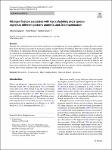Item Infomation
Full metadata record
| DC Field | Value | Language |
|---|---|---|
| dc.contributor.author | Sjøgren, Toke Due | - |
| dc.contributor.author | Wang, Yinliu | - |
| dc.contributor.author | Rousk, Kathrin | - |
| dc.date.accessioned | 2023-08-09T02:03:45Z | - |
| dc.date.available | 2023-08-09T02:03:45Z | - |
| dc.date.issued | 2023 | - |
| dc.identifier.uri | https://link.springer.com/article/10.1007/s11356-023-28404-0 | - |
| dc.identifier.uri | https://dlib.phenikaa-uni.edu.vn/handle/PNK/8746 | - |
| dc.description | CC-BY | vi |
| dc.description.abstract | Nitrogen (N2) fixation by moss-associated cyanobacteria is an important N source in pristine ecosystems. Previous studies have shown that moss-associated N2 fixation is sensitive to anthropogenic N pollution. However, we still lack understanding of the effects of other factors derived from anthropogenic sources, such as heavy metal pollution on N2 fixation. To test this, we collected two dominant mosses (Pleurozium schreberi and Spaghnum palustre) from a temperate bog in Denmark and assessed their N2 fixation responses to simulated heavy metal pollution by adding 5 levels (plus a control) of copper (Cu, 0–0.05 mg g dw−1) and zinc (Zn, 0–0.1 mg g dw−1). Metal concentrations in both mosses increased linearly with Cu and Zn addition, but N2 fixation activity associated with S. palustre was to a greater extent negatively affected by both Cu and Zn additions than that associated with P. schreberi. Copper additions even promoted N2 fixation in P. schreberi. | vi |
| dc.language.iso | en | vi |
| dc.publisher | Springer | vi |
| dc.subject | Nitrogen (N2) fixation | vi |
| dc.subject | anthropogenic N pollution | vi |
| dc.title | Nitrogen fixation associated with two cohabiting moss species expresses different patterns under Cu and Zn contamination | vi |
| dc.type | Book | vi |
| Appears in Collections | ||
| OER - Khoa học môi trường | ||
Files in This Item:

